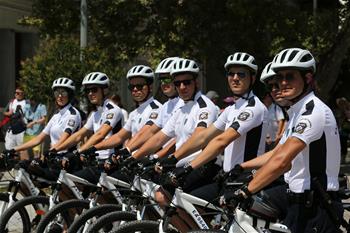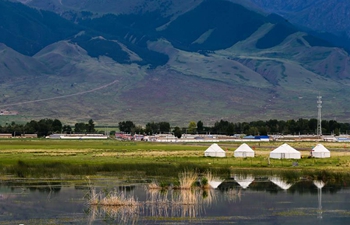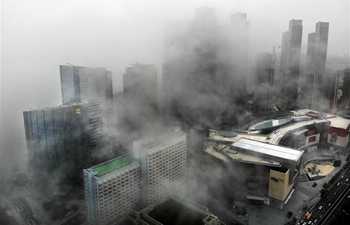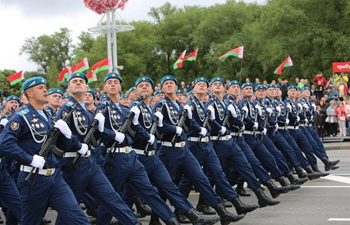URUMQI, July 7 (Xinhua) -- Wang Yuan is waiting for a rainbow. It is her job, and she hopes to be a rainbow forecaster that can predict the meteorological phenomenon 10 hours in advance.
The weather favors her. At 9:55 p.m. on June 30, the clouds disappeared, and the sun came out. A multicolored circular arc was hanging in the deep, blue sky.
"In July, rainbows can be seen here almost five times in 10 days, and sometimes two or three times a day," says Wang, deputy director of the meteorological bureau of Zhaosu County in Xinjiang Uygur Autonomous Region.
Zhaosu is located in a mountainous basin, about 880 km away from the regional capital of Urumqi. It is frequented by thunderstorms and hail in summer. From June to August, convective clouds grow quickly into afternoon thunderstorms, and there is always rain in the eastern sky while the sun sets in the west, creating perfect conditions for rainbows.
Conditions for rainbows include sunshine, water vapor and clear air. When sunlight encounters a raindrop, light is reflected and refracted, and rainbows appear.
It is nothing new for locals, but pictures of rainbows are sweeping across social media, such as Weibo and WeChat. "I never thought that people would care about rainbow so much," Wang says.
The popularity of rainbows on social media made Wang realize that rainbows could attract visitors and bring wealth to locals.
In March 2017, Wang and her colleagues established a rainbow forecast team. Four month later, they have forecast a rainbow one hour in advance.
Wang became more confident after the success, but has found rainbow forecasting complex.
"We forecast rainbow occurrences and locations mainly based on the record of time and weather conditions when rainbows have usually appeared in Zhaosu over the years, as well as weather forecasts, radar and cloud maps of the day," Wang says.
Gao Hui, director of the local meteorological observatory, says forecasting rainbows is more difficult than forecasting rain or temperature, because rainbows cannot be observed by instruments.
A rainbow's starting and ending times, location, elevation angle, as well as the cloud and solar orientation when rainbow appears, can only be recorded through manual observation.
Furthermore, the position of observer is also important. A rainbow can be seen only when the sun, observer and rain are aligned, with the observer in the middle. Therefore, rainbow forecasters need accurate calculations of the position between rain, rainbow and sun.
Sometimes a rainbow can only be seen from within five square kilometers, and its appearance is very brief, so observers have to drive to chase it. Wang has often chased rainbows and failed.
Last year, the local meteorological bureau launched a "Rainbow Runner" competition online, calling on web users to record and photograph rainbows, receiving more than a hundred photos.
Web users have helped increase rainbow observation data. Wang's team has gathered all the rainbow and related meteorological data of the past year.
The peak season for rainbows in Zhaosu is June, July and August, when about 90 percent of rainbows for the year appear.
The team also found that rainbows often show up after 9 p.m., and members have marked a few sites as hot-spots for frequent rainbow viewing.
Wang says the closer the forecast to the time a rainbow appears, the higher the accuracy, which can reach 85 percent. If the forecast is made more than 10 hours in advance, the accuracy is 50 to 60 percent.
The rainbow forecast service is in trial operation and will be officially launched next June.
Rainbow forecasting has been praised as an innovation in meteorological observation. Zhang Tao, chief forecaster of National Meteorological Center, says that since the founding of New China the most important task of traditional meteorological services was to serve agricultural needs. Until the 1980s, weather forecasts were mainly shown on television to help disaster prevention.
"Rainbows are not an important weather phenomenon. That's why the meteorological authorities have never made rainbow forecasts before," Zhang says.
With improvements in living standards, people have more new demands on meteorological services. Apart from rainbow forecasting, meteorological departments are providing many new services, including blue sky forecasts and mosquito maps, which have proved popular.
"Rainbow forecasts may help boost local tourism and become a regular meteorological service," Zhang says.

















